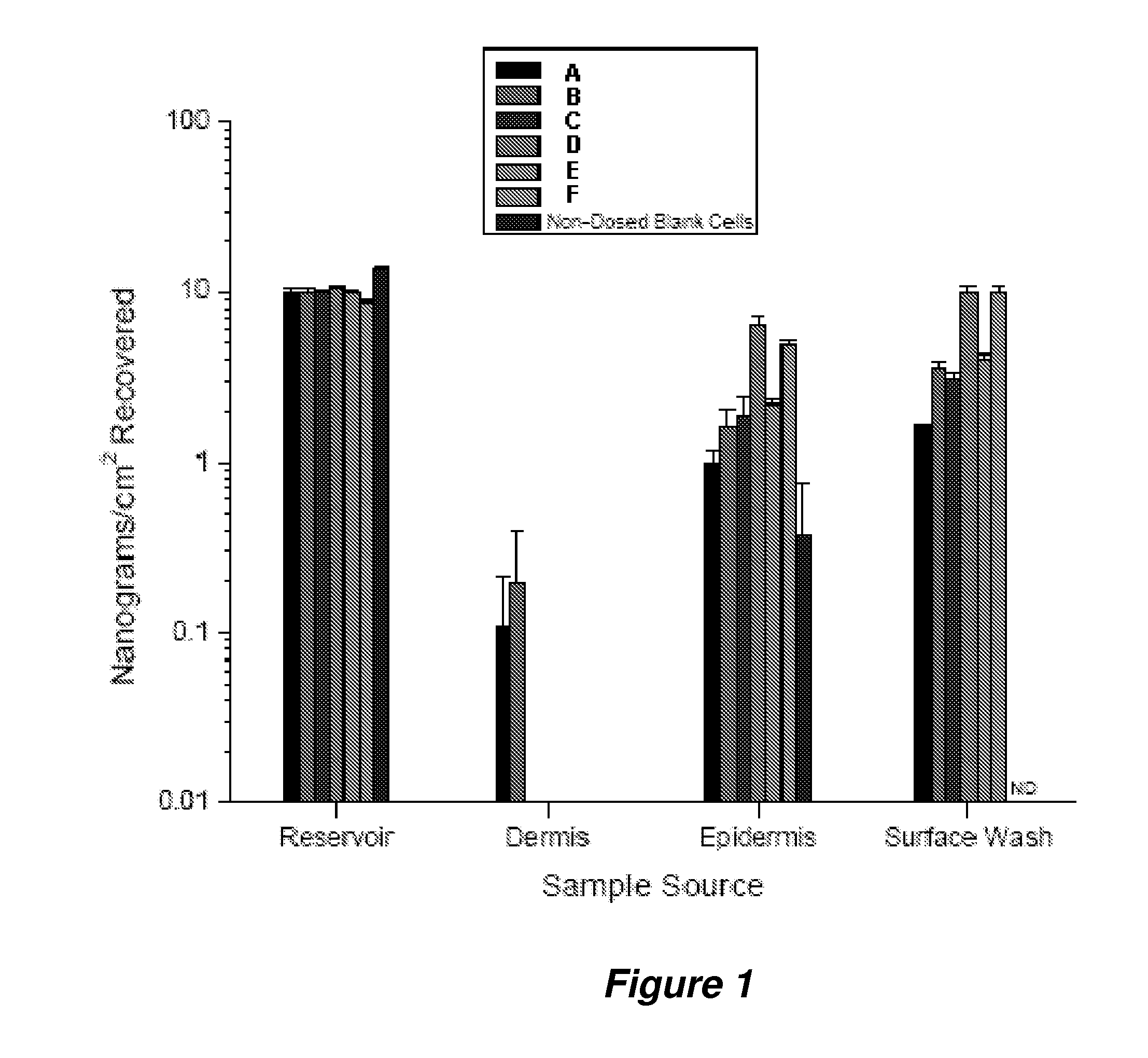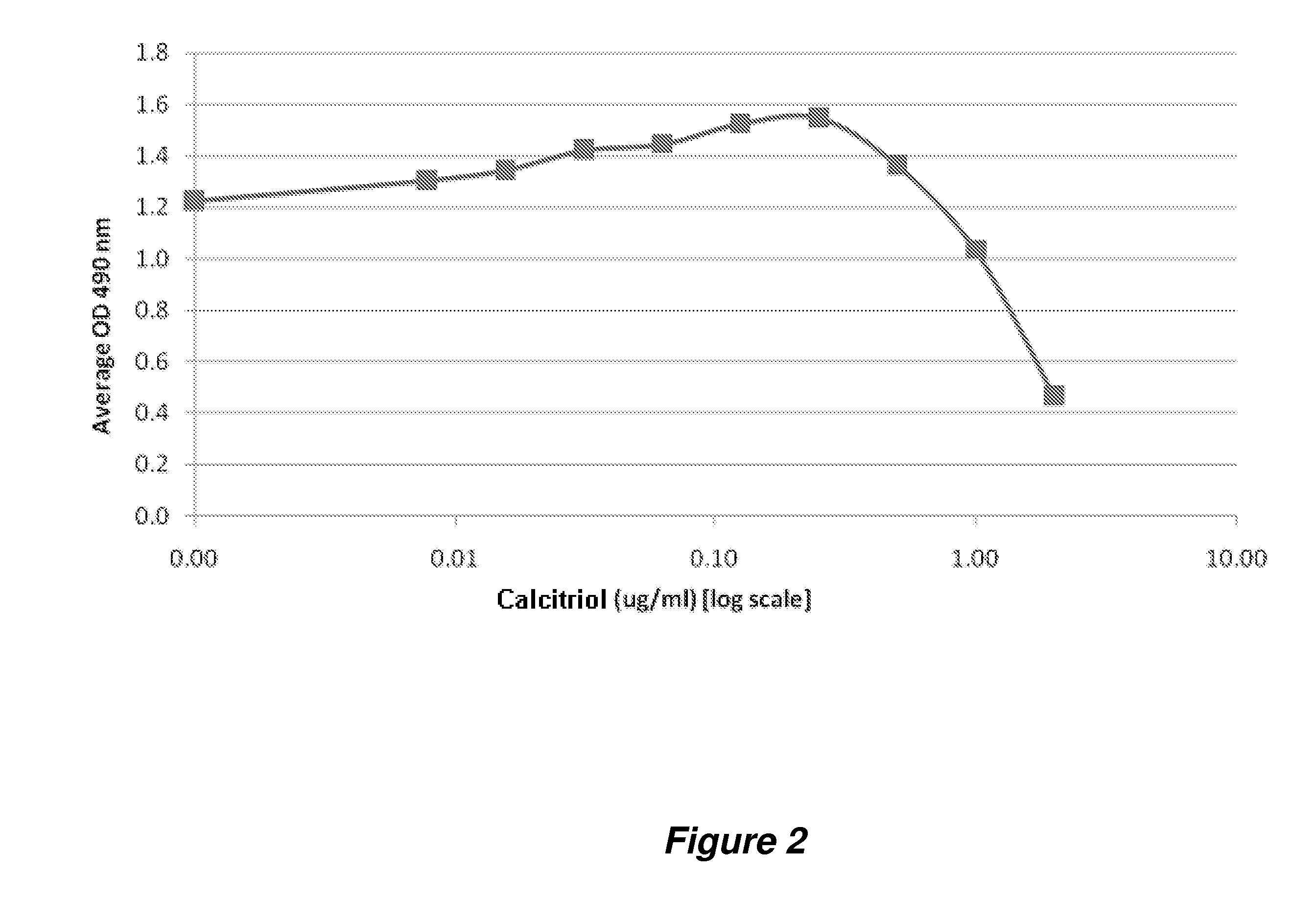Vitamin d3 and analogs thereof for treating alopecia
a technology of vitamin d3 and alopecia, applied in the field of vitamin d3 and analogs thereof for treating alopecia, can solve the problems of no approved therapeutic agent, few effective preventive measures, and sufferers of alopecia can only attempt to regrow lost hair
- Summary
- Abstract
- Description
- Claims
- Application Information
AI Technical Summary
Benefits of technology
Problems solved by technology
Method used
Image
Examples
example 1
Evaluation of the Percutaneous Absorption of Calcitriol, In Vitro, Using the Franz Human Skin Finite Dose Model
[0295]This example was designed to evaluate the percutaneous absorption pharmacokinetics of various calcitriol formulations. Absorption was measured in human cadaver skin, in vitro, using the finite dose technique and Franz Diffusion Cells. The in vitro human cadaver skin model has proven to be a valuable tool for the study of percutaneous absorption and the determination of the pharmacokinetics of topically applied drugs. The model used human cadaver skin mounted in specially designed diffusion cells that allowed the skin to be maintained at a temperature and humidity that match typical in vivo conditions. A finite dose (e.g., 4-7 mg / cm2) of formulation was applied to the outer surface of the skin and drug absorption was measured by monitoring its rate of appearance in the receptor solution bathing the inner surface of the skin. Data defining total absorption, rate of abso...
example 2
Identification of Key Proteins Involved in Epidermal Cell Culture Response to Calcitriol—Real Time PCR (RTPCR)
[0320]This and the following several examples provide additional information regarding the identity of proteins or genes in the activation pathways for Calcitriol. These experiments allow the identification of the mechanism of action and key proteins / genes involved in the cellular response of epidermal cells to vitamin D compounds.
[0321]Specifically, it was found that exposing the keratinocyte cell line HEKa to calcitriol caused a significant impact on cellular processes. The experiments described herein focus on the identification of key proteins / genes that were involved in calcitriol induced changes in calcium channel transport and changes in regulation of heat shock proteins. Real-time polymerase chain reaction (RTPCR) methods were employed in this example to identify changes in the level of mRNA's for genes involved in ion channels, transport proteins, and heat shock pro...
example 3
Identification of Key Proteins Involved in Epidermal Cell Culture Response to Calcitriol—Antibody Array
[0335]Evaluation of protein changes upon calcitriol stimulation was also evaluated through utilization of antibody microarrays, which are capable of screening for changes in over 700 potential target proteins.
[0336]In this experiment, an antibody microarray (Panorama XP725 Antibody Array, Sigma) encompassing antibodies against over 700 target proteins was utilized to assess changes in protein concentration / level in HEKa cells treated with calcitriol for about 3, 6, or 24 hours, respectively. Briefly, the treated HEKa cells were first harvested and then extracted to obtain a soluble protein supernatant. Two portions of the extracted protein sample (˜1 mg total) from each sample (at 1 mg / mL) were each labeled with fluorescent dye (Cy3 and Cy5, respectively). The excess dye was removed from the protein sample, and the resulting labeled protein samples were used for microarray incubati...
PUM
| Property | Measurement | Unit |
|---|---|---|
| body weight | aaaaa | aaaaa |
| weight | aaaaa | aaaaa |
| concentration | aaaaa | aaaaa |
Abstract
Description
Claims
Application Information
 Login to View More
Login to View More - R&D
- Intellectual Property
- Life Sciences
- Materials
- Tech Scout
- Unparalleled Data Quality
- Higher Quality Content
- 60% Fewer Hallucinations
Browse by: Latest US Patents, China's latest patents, Technical Efficacy Thesaurus, Application Domain, Technology Topic, Popular Technical Reports.
© 2025 PatSnap. All rights reserved.Legal|Privacy policy|Modern Slavery Act Transparency Statement|Sitemap|About US| Contact US: help@patsnap.com



